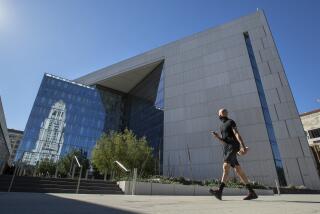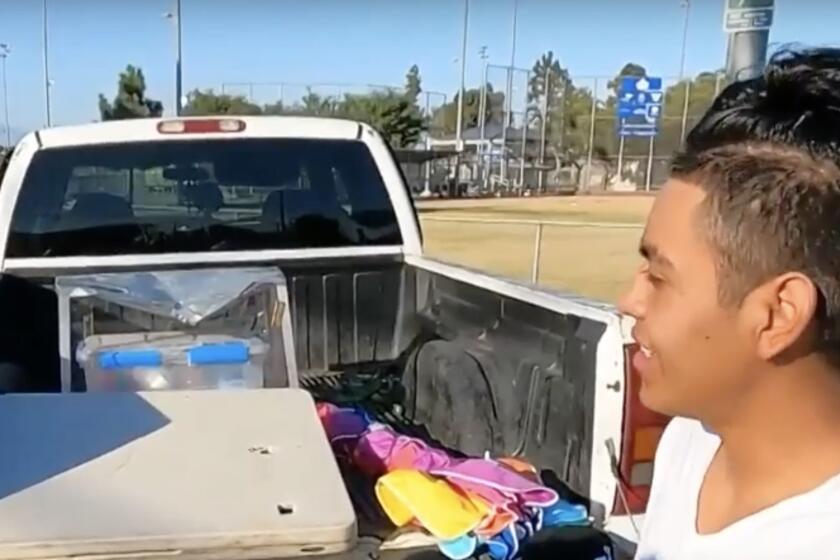LAPD botched use of downtown crime cameras
Most of the surveillance cameras installed in downtown Los Angeles as part of an effort to help police crack down on crime have not been working for two years, according to interviews and records reviewed by The Times.
The cameras were installed over the last few years in a highly publicized partnership between local business groups, which purchased them, and the Los Angeles Police Department, which was to monitor and maintain them.
But officials said the majority of the cameras don’t work. Some broke down and were never fixed. In the case of six cameras purchased to watch over Little Tokyo, LAPD officials admit that they were never plugged in to the police station’s monitoring bank.
Frustration about the broken cameras has deepened in recent days after a string of recent stabbings on a block in skid row. In one case, a 53-year-old man died after being stabbed and beaten by more than half a dozen attackers. No arrests have been made.
A camera is located just above where the stabbings occurred, but officials said it was not working properly.
“It is heartbreaking to see a network of cameras gifted to the LAPD sitting idle while perpetrators of violence get away with murder on our most dangerous streets,” said Estela Lopez, the executive director of the Central City East Assn., which donated 10 cameras to monitor areas of skid row in 2006 at a cost of $200,000. “Just when the demand on the missions and shelters is going up, we need to use every tool we can to keep violence from ripping this community apart.”
LAPD officials acknowledged that the department has not been properly maintaining or monitoring the three dozen or so downtown cameras.
One problem is that officers were not properly trained on how to use the camera system and ended up in some cases breaking it, according to police and business officials. Officers are supposed to monitor the cameras from a control room in the Central Police Station, using joysticks to manually pan, tilt and zoom the cameras. But the system sometimes overheated because it was placed in a room the size of a closet.
The department has struggled to find a vendor who can regularly maintain the cameras.
“It’s like buying a car without an extended warranty,” LAPD Deputy Chief Jose Perez Jr. said. “We know the reasons it doesn’t work. Now we are trying to make it work.”
The situation frustrates Police Commissioner Alan Skobin, who says it reflects a larger problem.
“We need to embrace technology, but it’s important that when the department promises something to the public that they follow through,” Skobin said. “The department has fallen short in meeting expectations in maintenance and repair provisions.”
The LAPD has about 300 cameras around the city, including ones purchased from government grants and by business groups.
The cameras have been credited with helping the LAPD drive down crime in places like MacArthur Park and Hollywood Boulevard.
But there has been criticism that the LAPD doesn’t have a coordinated system for maintaining the cameras. In 2008, the Police Commission slammed the department after it discovered that some of the cameras in MacArthur Park were not working and that the LAPD’s Rampart Division didn’t have the money to fix them.
Some of the inoperative cameras were caked with pigeon droppings.
The LAPD has since fixed those cameras. But Lopez, of the Central City East Assn., said she’s been frustrated by the department’s slow response to fixing the downtown cameras.
“Frankly, I got tired of asking,” she said. “I threw my hands up. It seems like at every turn there was an impediment to putting these cameras to the use for which they were intended.”
The camera installations coincided with a major effort to combat crime in downtown Los Angeles, which has seen a revitalization with new lofts, restaurants and shops in the last decade. Perez said crime has fallen significantly in downtown in recent years.
But still, he and others said, the cameras can be a strong tool for police if they are working properly.
“We need to do a much better job of capitalizing on the generosity of our public and private partners by effecting a comprehensive strategy to monitor these cameras,” said Capt. Horace Frank of the LAPD Central Division. “I can assure the public that we are doing just that right now.”
More to Read
Sign up for Essential California
The most important California stories and recommendations in your inbox every morning.
You may occasionally receive promotional content from the Los Angeles Times.











